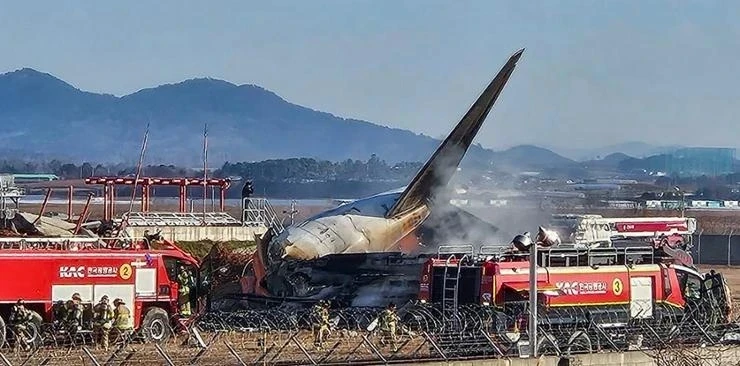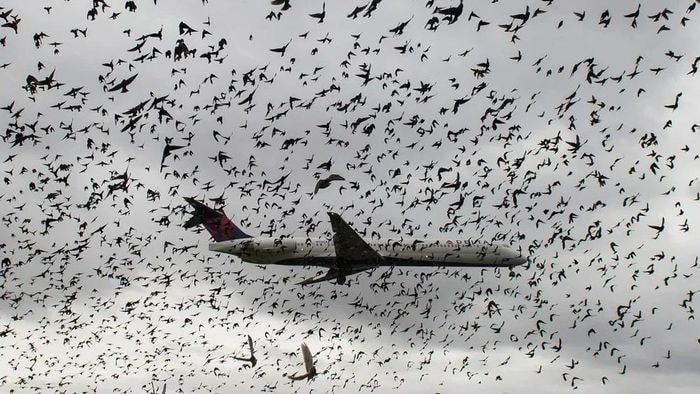For small aircraft, especially single-engine aircraft, bird strikes can be devastating. Since 1988, there have been 262 deaths and 250 aircraft destroyed worldwide.

Today, December 29, a South Korean plane carrying 181 people crashed off the runway and caught fire at Muan Airport (South Korea), killing 179 people. The initial cause was determined to be a bird strike.
The first incident of a plane colliding with a bird occurred in 1905, in a cornfield in Ohio (USA).
These types of incidents occur every day today and vary with the bird's migration seasons.
The most famous bird strike incident occurred in 2009, when a US Airways flight hit a flock of migrating Canada geese shortly after taking off from LaGuardia Airport in New York City.
Both engines of the plane failed, forcing Captain Sully Sullenberger to land the plane in the Hudson River. All on board were safe.
Between 2008 and 2017, the Australian Transport Safety Bureau recorded 16,626 bird strike incidents. In the US, the Federal Aviation Administration (FAA) reported 17,200 such incidents in 2022 alone.
According to the International Civil Aviation Organization (ICAO), 90% of bird strikes occur near airports. Typically, this happens when the plane is taking off, landing, or flying at low altitudes, similar to the flight range of birds.

The impact of an incident depends on a number of factors, including the type of aircraft. Consequences can include engine failure, as happened with a Virgin Australia flight in June.
The plane's engine caught fire shortly after takeoff from Queenstown Airport (New Zealand). The plane then had to make an emergency landing at Invercargill Airport, New Zealand. All 73 people on board were safe.
However, for small aircraft, especially single-engine aircraft, bird strikes can be more devastating. Since 1988, there have been 262 deaths due to bird strikes worldwide and 250 aircraft destroyed.
Most bird strikes occur early in the morning or at dusk when birds are most active. Pilots are trained to be alert during these times.
Radar can be used to track flocks of birds. However, this technology can only be used in some places, as it is ground-based and not yet available everywhere in the world.
The two largest aircraft manufacturers, Boeing and Airbus, both use turbofan engines. These engines work by using propellers to compress air before mixing it with fuel and combusting it to create the thrust needed for the plane to take off.
When a bird hits one of these engines, it can cause severe damage to the blades and cause the engine to fail. To test the safety of the engine, manufacturers perform a test by shooting a frozen chicken into the engine while it is running at full power.
The Australian Government's Civil Aviation Safety Authority in its wildlife hazard management guidelines outlines what airports need to do to keep birds and animals away from airport areas.
One method is to use small gas explosions to create a sound similar to a shotgun blast to scare birds away from areas near runways.
In areas with high bird density, airports can also plant grasses and trees that do not attract birds.
According to the Langley Advance Times, before the disaster in South Korea on December 29, there were five deadliest bird strikes in human history.
5.In 2009, in Louisiana (USA), a red falcon crashed through the windshield of a Sikorsky S-76 helicopter. The impact shattered the windshield, activated the engine fire suppression system, caused the helicopter's throttle to slow down and the engine to lose power. The accident killed 8 of the 9 people on board.
4.In Paris, France, in 1995, a Dassault Falcon 20 inhaled several pigeons during takeoff, severing fuel lines and causing one engine to fail. A fire broke out in the rear passenger compartment and the pilot lost control while attempting an emergency landing. All 10 passengers on board were killed.
3.Also in 1995, in Alaska (USA), a Boeing E-3 Sentry of the US Air Force sucked two Canada geese into its engines while taking off. The engines began to drain fuel and lost power, causing the plane to lose altitude. The plane crashed into the forest and exploded, killing all 24 crew members.
2.In 1988, in Bahir Dar, Ethiopia, a flock of zebra doves were sucked into the engines of a Boeing 737 as it took off from the runway. One of the engines lost power immediately. The other engine failed shortly after as the plane made an emergency landing. The plane landed and caught fire, killing 35 of the 98 passengers.
1.In 1960, in Boston, Massachusetts, a Lockheed L-188 Electra flew through a flock of 120 starlings shortly after takeoff, causing all four engines to fail before the plane crashed into Boston Harbor. The time from takeoff to impact with the water was less than a minute. 62 of the 72 passengers on board were killed.